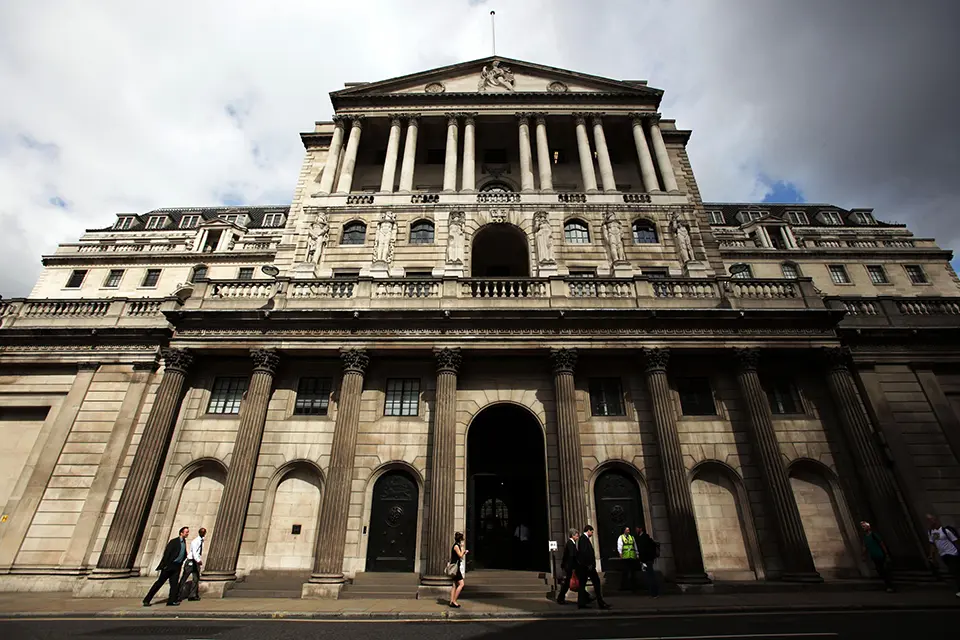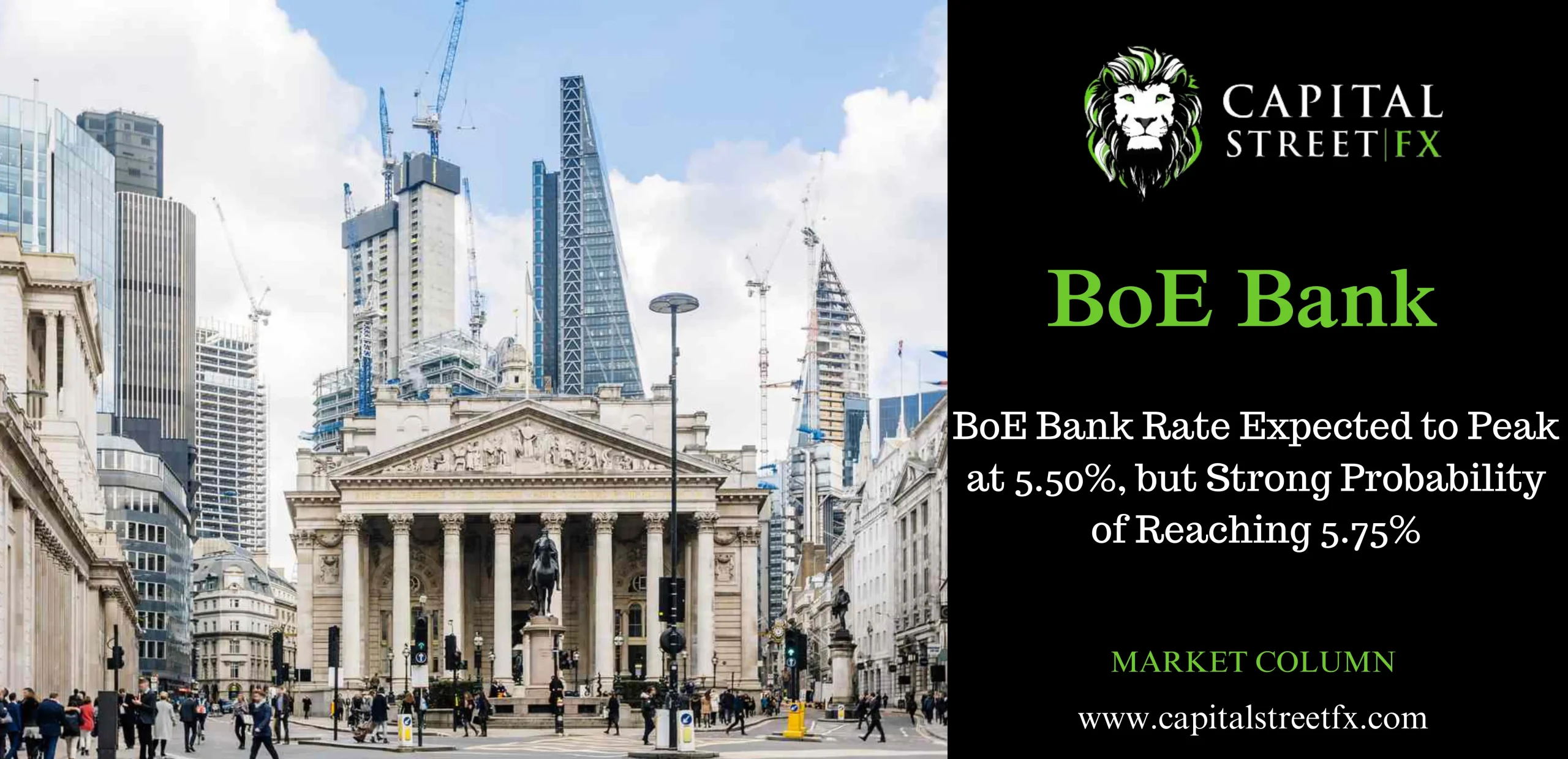BoE Bank Rate Expected to Peak at 5.50%, but Strong Probability of Reaching 5.75%.
Introduction
In a financial landscape colored by uncertainty and speculation, the Bank of England (BoE) stands at a crossroads. With the possibility of a further interest rate hike to 5.50% looming on September 21, experts remain divided on the path ahead. While the BoE has maintained a consistent upward trajectory, distinguishing itself with 14 consecutive months of rate increases, contrasting signals from other major central banks complicate the narrative. This article delves into the intricacies of this dynamic, exploring the potential for both near-term and longer-reaching effects.

UK’s Inflation Battle: Striking a Balance
High Inflation: A Persistent Challenge
The United Kingdom’s inflation rate has emerged as a formidable contender on the Western European stage, overshadowing its counterparts and stubbornly surpassing the BoE’s targeted 2%. Recent figures illustrate a marginal decrease, with July witnessing a drop to 6.8% from the previous month’s 7.9%. Despite this reduction, the overarching dilemma of soaring inflation remains far from resolved.
Core Inflation’s Resilient Stance
Core inflation, a crucial yardstick that gauges price increases while excluding the volatile costs of gasoline and food, maintains its unwavering stance. Resisting fluctuations, it serves as an essential point of reference for the BoE’s vigilant monitoring. The steadfastness of core inflation underlines the multifaceted nature of the challenges facing monetary policy.
Forecasting the BoE’s Path: A Delicate Balance
Expert Projections: Anticipating Peaks
As whispers of potential rate hikes swirl, experts convene to chart the trajectory of the Bank Rate. A recent Reuters poll offers insights into prevailing sentiments. Notably, the consensus points to a potential peak at 5.50%, diverging from the earlier forecast of 5.75% in July. James Smith of ING underscores the gravity of the situation, noting that the Bank’s acknowledgment of its restrictive policies sets the stage for a pivotal shift in market perception.
Weighing Risks: A Tug of War
While the prospect of restraint appeals to many, the dynamics of rate increases merit careful consideration. Out of 25 respondents, a staggering 88% (22 individuals) highlight the possibility of a riskier outcome—anticipating a terminal rate estimate surpassing expectations. In contrast, a minority trio envisions a lower trajectory. This divergence of opinion showcases the intricate dance between caution and boldness.
The Tidal Shift: Unveiling Poll Insights
Experts Unveil Predictions
A comprehensive poll encompassing 62 economists reveals a near-unanimous consensus. An overwhelming majority—bar one—forecasts a 25-basis point surge, propelling the bank rate to 5.50% in the imminent future. Notably, one outlier envisions a bolder half-point increase, punctuating the cautious consensus.
Inflation’s Role: Shaping the Path
Delving deeper into the figures, a pivotal role for inflation becomes evident. Despite persistent inflationary pressures, experts sway towards a tempered outlook, a tone echoing financial market predictions. A nuanced balancing act between high inflation and economic projections shapes the narrative, with a focus on achieving equilibrium.
Gazing into the Future: Varying Peaks
Crystal ball gazers remain divided over the eventual peak. While some foresee a pinnacle of 5.75%, others temper their expectations at 6.00%. The intricacies of economic prediction come to the fore as experts debate the ceiling of the Bank Rate, projecting diverse trajectories.
Nuances Amidst Uncertainty: A July Prelude
Prior Poll: Insights from July
A retrospective glance to July’s poll showcases the ebb and flow of expert sentiment. In this landscape of uncertainty, a narrow majority—51%—envisaged the bank rate ascending to 5.75% or beyond by year’s end. This snapshot captures the nuances of sentiment as experts grapple with the evolving landscape.
GEMMs’ Divided Verdict
Among the experts, the Global Economic Market Models (GEMMs) paint a picture of division. A split verdict emerges as 15 participants share their perspectives. An even split between 5.75% and 5.50% reveals the complexity of forecasting in a volatile environment.
Changing Tides: Shifting Projections
Intriguingly, contributors who partook in both July and current surveys showcase fluctuating opinions. Nine voices echo a reduction of at least a quarter point in their peak rate projection, notably including five GEMMs. On the other hand, the majority remain resolute, with 37 experts reaffirming their earlier projections.
Economy at a Crossroads: Potential Recession Looms
Alarming Signals: PMIs Speak
The alarm bells ring louder as Purchasing Managers’ Indices (PMIs) unveil a disconcerting narrative. A declining factory output, coupled with overall economic fragility, intersects with rising interest rates. These elements conjure the specter of a potential recession, casting shadows on Britain’s economic landscape.
Inflation’s Elusive Retreat
PMIs serve as a stark reminder of the arduous journey to curb inflation from double digits to the coveted 2%. As they hint at an impending recession, Simon Wells of HSBC deciphers the indices’ message. The delicate dance between inflation and economic stability takes center stage, punctuating the prevailing challenges.
Battling the Odds: Economic Resilience
Despite grappling with the dual challenges of inflation and high borrowing costs, the UK’s economy has thus far managed to avert recession. With predictions for average growth of 0.3% and 0.5% in the upcoming years, the nation stands at a crossroads, navigating uncharted waters with a blend of resilience and caution.
FAQs
FAQ 1: Will the BoE Increase Rates Beyond 5.50%?
Answer: While the consensus currently points to a peak at 5.50%, 22 out of 25 experts acknowledge the possibility of rates surpassing this threshold. The delicate interplay of factors keeps the door ajar for unexpected turns.
FAQ 2: How Does Core Inflation Impact Policy?
Answer: Core inflation, a steadfast indicator, exerts substantial influence on policy decisions. It gauges price increases sans volatile elements, guiding the BoE’s measures in the face of evolving economic dynamics.
FAQ 3: What Do PMIs Reveal About the Economy?
Answer: PMIs, with their finger on the pulse of industrial output, highlight economic health. The recent decline, coupled with rising rates, raises concerns of recession—a stark reminder of the challenges ahead.
FAQ 4: Are GEMMs Consistently Aligned?
Answer: GEMMs, a group of economic minds, portray a divided front. Their varied projections, split between 5.75% and 5.50%, underscore the intricacies of forecasting in a complex financial landscape.

